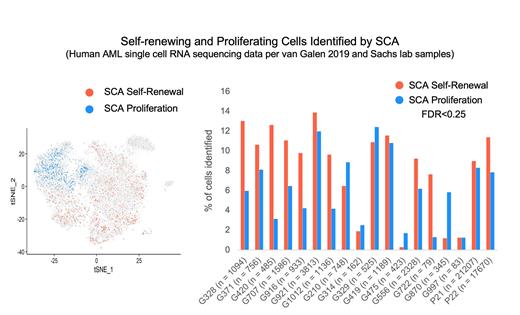Introduction
Acute myeloid leukemia (AML) is an aggressive hematopoietic malignancy. Despite early response to standard chemotherapy, 60-70% of patients relapse with treatment resistant disease and die of relapsed disease. Leukemia stem cells (LSCs), the subpopulation of leukemia cells with self-renewal capacity, can recapitulate leukemia to cause relapse. Ongoing work to define therapeutic targets that can block self-renewal would prevent relapse and disease progression in AML. Prior work has established that LSCs express a distinct gene expression profile. We sought to define the gene expression profile of self-renewal at the single-cell level because a precise understanding of the transcriptional basis for self-renewal could provide more effective therapeutic targets. Our group previously demonstrated that activated NRAS (NRAS G12V) mediates self-renewal in the LSC-enriched subpopulation of AML in the Mll-AF9/NRAS G12V mouse model of AML (Sachs 2014). Single cell RNA-sequencing (scRNA-seq) of the LSC-enriched subpopulation identified three distinct transcriptional profiles. Two genes that encode cell surface markers, Cd36 and Cd69, delineate these distinct profiles. Using in vivo leukemia engraftment assays, we found that only the CD36 -CD69 + LSC subgroup repopulates leukemia while the CD36 +CD69 - LSC subgroup does not, demonstrating that self-renewal capacity is limited to the CD36 -CD69 + subset of the LSC-enriched compartment (Sachs 2020). In contrast, the CD36 +CD69 - LSCs were highly proliferative while the CD36 -CD69 + LSCs were poorly proliferative. These experiments show that self-renewal and rapid proliferation are mutually exclusive features of LSCs, as has previously been shown in normal hematopoietic stem cells (Li 2013).
Methods and Results
We investigated whether primary human AML stem cells express the murine-derived single-cell self-renewal and proliferation gene expression profiles at the single-cell level. Current computational methods to compare single-cell gene expression profiles use arbitrary similarity scores and do not assess the statistical significance of their findings. Therefore, we developed a new computational method called Single cell Correlation Analysis (SCA). SCA is designed to quantitate the expression of a predefined profile in single-cell RNA sequencing data. The quantification of the expression profiles is assessed on a per-cell basis in an unsupervised manner, meaning that SCA does not rely on any pre-sorting or classification of the query cells. The significance of the quantitative metric (i.e. level of expression) is determined by permutation-based false discovery rate testing. SCA can therefore identify cells that express a profile of interest within a single-cell RNA sequencing dataset and incorporates a measure of statistical significance to that assignment.
We used SCA to analyze scRNA-seq data from primary human AML samples. We used data from two samples sequenced by our group and previously published data from 16 samples (van Galen 2019). SCA identified cells that express the murine single-cell self-renewal profile in every sample (0.32-11.5%; FDR < 0.25). We sorted two primary human AML samples to isolate LSCs (CD34 +CD38 -) prior to single-cell capture and sequencing. SCA identified cells that express murine LSC self-renewal profile in both of these samples as well (8.9-11.3%; FDR < 0.25). Furthermore, with these analyses, we found that the single-cell profiles of self-renewal and proliferation were mutually exclusive in human LSCs, as they are in murine LSCs and normal HSCs. We performed gene set enrichment analysis (GSEA) and confirmed that the human cells that express the murine single cell self-renewal profile are enriched in previously reported LSC self-renewal gene expression profiles.
Conclusion
We present SCA, a novel computational method designed to quantitatively assess single-cell transcriptional datasets and evaluate the statistical significance of its results. Using this method, we demonstrate that primary human AML samples express the single-cell profiles of self-renewal that we previously validated experimentally. SCA-based identification of human self-renewing cells will allow us to interrogate novel transcriptional features of these cells in future studies.
Disclosures
No relevant conflicts of interest to declare.


